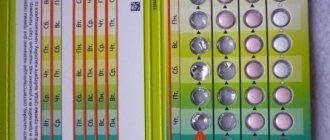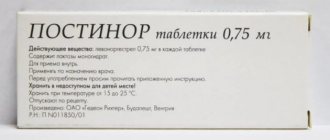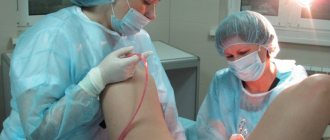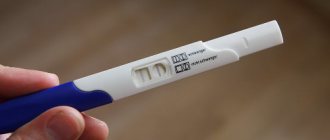First menstruation after curettage
The most important evidence of a correctly performed operation is the reappearance of menstruation after cleaning. The first menstruation after a diagnostic procedure prescribed due to a miscarriage, frozen fetal development, or removal of a polyp should normally be the same as before curettage. Everything must match - the duration of the cycle, the amount of blood, the composition of the discharge, its appearance, color, consistency, smell.
If after cleaning your period starts too early, the discharge is heavy, or there is a delay in the cycle, abdominal pain occurs, or the temperature rises, an examination by a gynecologist is urgently required. Such violations are associated with emerging pathologies or an incorrectly performed operation. A repeat procedure may be necessary.
https://youtu.be/mFypXlxGDkM
Endometrial damage
When cleaning the uterus, the top layer of the organ cavity is very easy to damage. In this case, delays in the menstrual cycle are possible.
When menstruation will begin after this is actually unknown, since each woman’s body is individual. It all depends on the nature and intensity of the damage, on hormonal levels and the health of the female organs.
Another reason why menstruation does not come after cleaning the uterus is pregnancy.
When to expect them
It may seem that after a complex and unsafe curettage process, menstruation may appear at some unspecified time - in a week or two, or in 9-10 weeks. This is wrong. The onset of menstruation is strictly established; it should not differ in any way from the duration of the menstrual cycle before the procedure. If the interval between ovulations was 27-28 days, then your period will have to start 4 weeks (or a month) after cleaning, because curettage does not affect the maturation of the egg. The procedure does not change hormonal levels.
The maximum period when menstrual flow should begin after the diagnostic curettage procedure reaches five to six weeks.
The maximum time when menstruation begins after cleansing a frozen pregnancy, as well as after any abortion, for example, during a miscarriage, should not be higher than six to seven weeks. The lengthening of the interval is associated with changes in hormone levels due to the beginning of gestation. It takes a little time for the body to transition to normal hormonal levels.
If the deadlines are violated, you should come for an examination to a doctor to avoid complications. For example, if your period started after 2 weeks, it may be due to bleeding. Another reason for this phenomenon is hormonal imbalance.
Each woman is individual, so the time of the onset of her first period may vary. The establishment of the cycle, its arrival normally lasts from 3 to 6 months. During this time, your periods are a little more painful than before.
Deviations
The most common anomaly is delayed menstruation. If after curettage there are no periods for 8 weeks, then you should get tested and consult a gynecologist.
The cause of the problem may be a spasm in the cervix, as a result of which blood and all discharge remain in the body. Due to the processes of decay, endometrial cells grow beyond this layer, inflammation of the visceral and parietal peritoneum of the small pelvis, as well as sexually transmitted diseases.
Another reason for the delay may be hormonal imbalance. Such changes are typical for curettage, which was performed to terminate a pregnancy. Due to the adjustment to gestation, active production of progesterone begins. Therefore, menstruation after abortive curettage is delayed.
When performing a cleansing to terminate a pregnancy, it is recommended to take oral contraceptives for a further 6 months; after the procedure, menstruation may cease from the cycle. Menstruation after therapeutic endometrial cleansing can also be significantly delayed due to the removal of deeper layers of the uterine mucosa.
Refusal of the gynecologist's recommendations leads to complications. Without antibiotics, inflammatory processes begin in the body, which lead to headaches, increased body temperature, unpleasant odor and color of discharge.
In addition to the delay, the long-awaited menstruation can last more than ten days, which indicates the occurrence of inflammatory processes that manifest themselves due to insufficient cleansing. Residues may include: blood clots, particles of fertilized egg, pieces of mucous membrane.
The main cause of cycle disorders is hormonal imbalances.
The norm for diagnostic curettage is menstruation every 21 days. If the cycle begins after 7 days, this indicates bleeding.
Types of discharge
After the procedure has taken place, it is necessary to pay all attention to the first periods after cleansing and their appearance. In different situations, the types of discharge may be as follows:
- Scanty, dark, pungent and unpleasantly smelling.
- Abundant, when the pad fills in less than 3 hours, with clots.
- Changed color, having a yellowish or greenish color.
- Red, bright color, flowing very strongly.
An unusual type of discharge may appear when particles remain in the uterus that have not been removed. These pieces of endometrium cause very scanty dark-colored discharge with an unpleasant odor. Such symptoms are associated with the process of inflammation. If the discharge is extremely strong, with clots coming out, there is also a suspicion that the surface of the uterine wall is not completely cleansed.
Green or yellow discharge is caused by inflammatory, infectious processes.
Very large blood losses may indicate damage to blood vessels. In this case, it is not advisable to stop the bleeding by self-medication. You need to see a doctor.
Normally, the discharge should not be abundant, but generally the same in color, without an unpleasant odor or clots. Menstruation after cleansing lasts a little less time than usual.
Bleeding after brushing
Immediately after uterine curettage surgery, bleeding may occur. If there is little blood, it does not come out in large clots, there are no sharp pains, and there is no need to worry too much. There are folk remedies that help stop blood loss - nettle decoction is the most accessible of them.
It is difficult to accurately measure at home how much blood is released. Therefore, measurements are taken using gaskets: if it requires replacement in less than three hours, you need to consult a doctor. The same technique will help to distinguish bleeding from menstruation if the discharge occurs a few days after the intervention.
Too much menstruation following an abortion is an alarming signal indicating that the fetus was not completely removed. Some of the remaining fragments of the embryo will come out through the vagina, and some will remain and begin to decompose, which is fraught with inflammation and blood poisoning.
Blood sometimes flows non-stop after endometrial hyperplasia, which indicates damage to the inner layers of the uterus. The patient should pay attention to the general condition: weakness, dizziness, abdominal pain are signs of complications.
Any of these cases requires an immediate visit to the antenatal clinic. The doctor will prescribe suitable hemostatic drugs and write a referral for examination.
How to distinguish pathological bleeding from normal
The pathology of the procedure can be indicated by a change in the woman’s well-being during her period after cleansing. Symptoms of the disease are:
Sharp, severe pain in the abdomen, throbbing pain.
- Scanty menstruation with odor.
- Clots in excessively heavy periods.
- Increase in temperature, its sudden jumps.
- Weakness, nausea, dizziness.
- Very heavy bleeding, reminiscent of uterine bleeding.
- Delayed menstruation for a long time.
The most difficult thing is restoring menstruation after cleansing, which was caused by a frozen pregnancy. Stopping fetal development does not allow delay in performing curettage, otherwise death may occur. But during the cleaning process, a small area of tissue lining the uterus may remain. Therefore, the condition of a woman in such a situation must be monitored especially carefully. You may have to wait up to 7 weeks for your period. The exact parameters depend on the characteristics of the female body.
How not to confuse periods and discharge after cleansing
Bloody discharge is generally normal after a uterine cleanse. But you need to monitor them to exclude menstrual irregularities and to know when your period will start.
It is necessary to understand that as a result of curettage, the uterine cavity practically becomes an open wound. So there is no need to be afraid of bleeding after the procedure. They usually last up to 6 days. After this, they turn into spotting until they disappear completely.
In total, the duration of postoperative discharge should not exceed 10 days. This process may be accompanied by mild nagging pain in the lower abdomen. If the operation was carried out on the eve of menstruation, then you should expect your period on time, and its duration should not exceed the norm - 6-7 days.
Discharge with an unpleasant odor after a curettage procedure is a reason to immediately consult a doctor
It is important to know! Pathological discharge after cleaning is not menstruation. If they appear, you should consult a doctor.
Such allocations include:
- Discharge that lasts more than 10 days;
- Stopping discharge too abruptly. This may mean that blood clots have formed in the uterine cavity;
- Brown color and unpleasant odor.
All this may indicate hormonal imbalances or the presence of infection. Such processes are accompanied by other complications, for example, fever, general malaise. Sometimes there is severe pain.
In some cases, you have to take medications, including antibiotics. And sometimes complications even lead to the need for repeated curettage.
Complications
The possible consequences of gynecological cleansing are not happy. Depending on the complexity of the case, the stage of pregnancy and the purpose of the curettage procedure, vacuum cleaning or using a curette can be used. After vacuum cleaning, there are usually fewer undesirable consequences. Curettage is more dangerous, as the instrument may slip and damage internal tissues. If very heavy discharge appears, especially earlier than expected, this almost always means that large blood vessels have been damaged. After curettage, the following complications are also possible:
- myometrial perforation;
- tear;
- spasm of the cervical canal;
- infection or inflammation of the endometrium and other tissues;
- pieces of placenta and endometrium remaining in the uterus;
- deep damage to the uterine tissue.
If the uterus is damaged, the problem is eliminated by sewing in the organ or removing it. When particles of dying tissue remain unscraped out, repeated cleaning may help.
What is uterine cleaning or curettage?
Curettage of the uterus or curettage is a procedure during which the doctor uses special instruments to remove the inner layer of the endometrium of this organ.
There are two types of indications for this procedure:
Curettage or curettage of the uterus is the removal of the internal endometrium using special medical instruments
1. Curettage can be performed for therapeutic purposes . This means that the patient has pathological formations removed from the uterine cavity. The main diagnoses for which curettage is prescribed:
— Elimination of polyps;
— Postpartum or post-abortion complications;
— Endometrial hyperplasia;
- Heavy bleeding.
Curettage can be done to diagnose uterine cancer
2. Curettage is done for diagnosis . In this case, there are several reasons:
— Control of pathological changes in the upper layer of the uterine cavity;
— Suspicion of malignant phenomena in the uterus;
— Examination before removal of fibroids;
— The appearance of myomatous nodes or their increase.
Delay of menstruation
A long absence of discharge after the curettage process is dangerous; it may indicate pathological results of the procedure. When there is no menstruation for a long time, a possible reason that contributed to the delay is a spasm of the cervical canal and cervix. In this case, the accumulation of blood and mucous secretions formed in the uterine cavity cannot leave it. This situation requires urgent medical intervention, since the blood changes while in the uterine cavity. It may begin to coagulate or decompose, which can be fatal. You cannot solve the problem on your own, without medical help.
At the very beginning of the body’s recovery after gynecological cleansing, the uterus remains very vulnerable. She should be protected. We need to help establish a normal monthly cycle and allow microdamages to heal. Therefore, it is recommended to abstain from sexual activity. If you don't do this, you may end up pregnant again. The new process of carrying an unborn child can cause a delay or complete absence of menstruation. The likelihood of conception occurs as soon as a new egg matures in the ovary. The time for the release of a new egg depends on many reasons, but doctors believe that if you do not give up sexual activity, pregnancy is possible even 8–14 days after curettage.
In order not to get pregnant, you need, on the advice of doctors, to take hormonal birth control pills. But taking them sometimes causes hormonal imbalances. Therefore, you need to switch to this method of contraception only after making sure of its safety.
What is curettage?
The uterus is a hollow organ consisting of muscles and covered inside with endometrium. The path to it leads through the cervix, located in the vagina.
During ovulation, the mucous membrane thickens so that the fertilized egg can attach.
If conception does not occur, during menstruation the upper layers of the endometrium are shed and come out along with vaginal discharge.
Curettage involves instrumental separation of the endometrium of the uterine cavity, required for various indications.
During the procedure, the gynecologist dilates the cervix to provide access to the hollow organ.
The woman may first be numbed with local anesthesia. And only then does it clean and collect biological material for histological examination. Its results will show the presence or absence of oncological changes in the uterus.
https://youtu.be/zZRYHY40YIY
How to restore and maintain the menstrual cycle
About 6 months or more should be allowed for complete restoration of the female body, birth canal, and all pelvic organs. Immediately after cleaning, the woman should take the prescribed antibiotics. They protect against the possible development of inflammation. Strict adherence to the recommended doses of medication and the timing of their administration is necessary even if you feel well.
To eliminate possible hormonal imbalances and regulate the menstrual cycle, the patient is prescribed hormone therapy. Although curettage does not affect the ovaries, the functioning of the reproductive system may change. To restore it faster and more correctly, you should take medications containing hormones. If you need to take OK, your choice should be taken very responsibly and carefully.
Following all doctors' recommendations is not enough. You need to carefully monitor your personal hygiene.
- In order not to injure or irritate the genitals, only sanitary pads should be used from hygiene products, choosing the highest quality, hypoallergenic ones.
- You cannot wear low-quality synthetic underwear.
- When washing, do not allow water to enter the vagina.
- Douching is prohibited.
Damage to blood vessels requires the use of hemostatic drugs. Severe pain can be relieved with analgesics. To prevent muscle strain, which leads to a rush of blood into the vessels, especially in the pelvic area, a woman should not lift any weights until complete recovery.
Curettage of the uterus: what is it, what types are there?
The following principles for classifying the procedure can be distinguished:
- by method of execution;
- depending on the use of additional tools;
- depending on the goals.
The table below shows characteristics of uterine curettage techniques.
| Principle of classification | Type of curettage | Description |
| Method of execution | Normal | The top layer is removed only from the uterine cavity. |
| Separate | The inner surface of the cervix is cleaned, and then the endometrium is removed from the uterine cavity. | |
| Using additional tools | Standard | During the procedure, the doctor works by touch, without seeing the cavity of the muscular organ. |
| Combined with hysteroscopy | A hysteroscope is inserted into the uterus, which allows you to examine the walls of the organ and observe how the cleaning process is progressing. | |
| Purpose of the procedure | Diagnostic | The operation is carried out in order to collect biomaterial for further diagnosis of diseases. |
| Medicinal | The procedure is aimed at removing pathological formations or the fertilized egg. |
Possible complications after the procedure
A planned procedure performed by an experienced specialist usually does not lead to complications. Negative consequences arise in the presence of the following factors:
- violation of the technique of performing the operation;
- incorrect diagnosis of the disease;
- ignoring concomitant pathologies;
- low immunity of women;
- presence of chronic diseases;
- non-compliance with medical recommendations during the rehabilitation period.
Complications can occur both in the first days after cleaning and after several weeks. Possible consequences:
- hormonal disbalance;
- rupture of the walls of the uterus;
- heavy uterine bleeding;
- formation of scars and adhesions;
- inflammation of the mucous membrane of a muscular organ as a result of infection;
- spasm of the cervix and accumulation of bloody clots in the organ cavity.
Complications can lead to menstrual irregularities, aggravated subsequent pregnancy, and infertility. Uterine bleeding is dangerous because it is difficult to stop. In some cases, it leads to organ removal or death.
- excessive blood loss (replacing sanitary pads more than once every 1.5 hours);
- the appearance of large clots, green or yellow mucus in the discharge;
- putrid odor of discharge;
- increased body temperature;
- spotting lasting more than 10 days;
- no periods for 40 days after the procedure.
How does curettage affect menstruation?
Scraping is used:
- With changes in the endometrium , when thickening and local formations are detected. When the endometrium is too thick, a diagnosis of hyperplasia is made. Curettage is prescribed for endometrial polyps. In this situation, if everything goes well, your period comes right away.
- With an irregular menstrual cycle . In this situation, curettage is performed if a woman has heavy, prolonged menstruation, and she cannot become pregnant. Also used for bleeding during menopause. How quickly the menstrual cycle is restored depends on how effective the curettage was and whether it solved the woman’s main problem.
- For pathologies of the cervix . When a gynecologist during an examination notices abnormal processes in the female organ and suspects a malignant tumor, curettage is required.
- In case of miscarriage . The procedure is carried out to completely cleanse the uterine cavity of tissue and placenta particles. Your period comes immediately after the procedure, if everything went well, it comes regularly.
- In case of a frozen pregnancy, curettage is required. The menstrual cycle is restored after 2 months.










